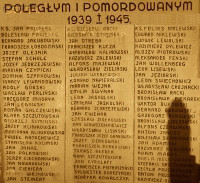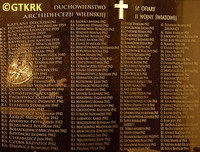Roman Catholic
St Sigismund parish
05-507 Słomczyn
85 Wiślana Str.
Konstancin deanery
Warsaw archdiocese, Poland
full list:
displayClick to display full list

searchClick to search full list by categories
wyświetlKliknij by wyświetlić pełną listę po polsku

szukajKliknij by przeszukać listę wg kategorii po polsku

Martyrology of the clergy — Poland
XX century (1914 – 1989)
personal data

surname
PAWELEC
forename(s)
John (pl. Jan)
function
religious cleric
creed
Latin (Roman Catholic) Church RCmore on
en.wikipedia.org
[access: 2014.09.21]
congregation
Society of St Francis de Sales SDBmore on
en.wikipedia.org
[access: 2013.05.19]
(i.e. Salesians of Don Bosco)
diocese / province
St Stanislav Kostka Warsaw Inspectorate SDB
Vilnius archdiocesemore on
en.wikipedia.org
[access: 2013.05.19]
RC Military Ordinariate of Polandmore on
en.wikipedia.org
[access: 2014.12.20]
date and place
of death
04.1942

n. Bobrowszczyznatoday: Bobruishchina, Hlybokaye dist., Vitebsk reg., Belarus
more on
be.wikipedia.org
[access: 2020.07.31]
alt. dates and places
of death
03.1942
n. Vilniustoday: Vilnius Cou., Lithuania
more on
en.wikipedia.org
[access: 2022.01.06]
Podsławn. Minsk
today: Belarus
details of death
After German and Russian invasion of Poland in 09.1939 and start of the World War II, moved to Vilnius, then under Lithuanian occupation (from 06.1940 under Russian occupation).
After ordination and after German attack on 22.06.1941 of their erstwhile ally, Russians, and start of German occupation, sent by Abp Romuald Jałbrzykowski in c. 09.1941 beyond former Polish border, north and east to Belarus, where Catholic had not seen a priest for 20 years.
Apparently settled in Pidświl, at Bobrowszczyzna parish in Hlybokaye deanery, and from there ministered in parishes to the east, in Belarus.
Prob. ministered as chaplain to the resistance Home Army AK (part of Polish Clandestine State) as well.
Arrested by the German and/or Belarusians in 03‐04.1942 in Bobrowszczyzna or its vicinity.
Driven out in unknown direction and prob. murdered.
cause of death
murder
perpetrators
Germans / Belarusians
sites and events
Ribbentrop‐MolotovClick to display the description, Pius XI's encyclicalsClick to display the description
date and place
of birth
16.05.1904Birth certification on:
www.genealogiawarchiwach.pl
[access: 2025.09.08]

Wąbrzeźnotoday: Wąbrzeźno urban gm., Wąbrzeźno pov., Kuyavia‐Pomerania voiv., Poland
more on
en.wikipedia.org
[access: 2021.09.02]
parents
PAWELEC Joseph
🞲 ?, ? — 🕆 ?, ?

JAWORSKA Helen
🞲 ?, ? — 🕆 ?, ?
religious vows
15.07.1933 (temporary)
17.07.1937 (permanent)
presbyter (holy orders)
ordination
20.04.1941

Vilniustoday: Vilnius city dist., Vilnius Cou., Lithuania
more on
en.wikipedia.org
[access: 2022.01.06]
positions held
1941 – 1942
priest — Padsvillietoday: Padsvillie ssov., Hlybokaye dist., Vitebsk reg., Belarus
more on
be.wikipedia.org
[access: 2022.09.11] ⋄ RC church ⋄ Bobrovshchisnatoday: Bobruishchina, Psuya ssov., Hlybokaye dist., Vitebsk reg., Belarus
more on
be.wikipedia.org
[access: 2020.07.31], St Anthony of Padua RC parish ⋄ Hlybokayetoday: Hlybokaye dist., Vitebsk reg., Belarus
more on
en.wikipedia.org
[access: 2021.10.09] RC deanery — ministry beyond the deanery borders, on the territory till 1941 under Russian control
c. 1940 – 1941
student — Vilniustoday: Vilnius city dist., Vilnius Cou., Lithuania
more on
en.wikipedia.org
[access: 2022.01.06] ⋄ theology, Theological Institute (higher theological seminary), Salesians of Don Bosco SDB
1939 – c. 1940
student — Saldutiškistoday: Saldutiškis eld., Utena dist., Utena Cou., Lithuania
more on
en.wikipedia.org
[access: 2022.09.11] ⋄ theology, Theological Institute (higher theological seminary), Salesians of Don Bosco SDB
from 1937
student — KrakówDębniki district
today: Kraków city pov., Lesser Poland voiv., Poland
more on
en.wikipedia.org
[access: 2021.12.18] ⋄ Theological Institute (higher theological seminary) at the Blessed Virgin Mary of the Immaculate Conception Congregation's house (known as „Łosiówka”), 30 Tyniecka Str., Salesians of Don Bosco SDB
1935 – 1937
friar — Jaciążektoday: Maków Mazowiecki gm., Płoniawy‐Bramura pov., Masovia voiv., Poland
more on
en.wikipedia.org
[access: 2022.09.11] ⋄ Society's House, Salesians of Don Bosco SDB — assistance (educational and pastoral practice)
from 1933
student — Marszałkitoday: Grabów nad Prosną gm., Ostrzeszów pov., Greater Poland voiv., Poland
more on
en.wikipedia.org
[access: 2021.12.18] ⋄ philosophy, Philosophical Institute (also known as the Philosophical Studentate), Salesians of Don Bosco SDB
1932 – 1933
novitiate — Czerwińsk nad Wisłątoday: Czerwińsk nad Wisłą gm., Płońsk pov., Masovia voiv., Poland
more on
en.wikipedia.org
[access: 2021.09.02] ⋄ Society's House, Salesians of Don Bosco SDB
till 1932
friar — Dashavatoday: Stryi urban hrom., Stryi rai., Lviv obl., Ukraine
more on
en.wikipedia.org
[access: 2022.09.11] ⋄ Society's House, Salesians of Don Bosco SDB — student at Minor Theological Seminary (gimnasium)
others related
in death
MARCINIAKClick to display biography Isidore
sites and events
descriptions
Ribbentrop‐Molotov: Genocidal Russian‐German alliance pact between Russian leader Joseph Stalin and German leader Adolf Hitler signed on 23.08.1939 in Moscow by respective foreign ministers, Mr. Vyacheslav Molotov for Russia and Joachim von Ribbentrop for Germany. The pact sanctioned and was the direct cause of joint Russian and German invasion of Poland and the outbreak of the World War II in 09.1939. In a political sense, the pact was an attempt to restore the status quo ante before 1914, with one exception, namely the „commercial” exchange of the so‐called „Kingdom of Poland”, which in 1914 was part of the Russian Empire, fore Eastern Galicia (today's western Ukraine), in 1914 belonging to the Austro‐Hungarian Empire. Galicia, including Lviv, was to be taken over by the Russians, the „Kingdom of Poland” — under the name of the General Governorate — Germany. The resultant „war was one of the greatest calamities and dramas of humanity in history, for two atheistic and anti‐Christian ideologies — national and international socialism — rejected God and His fifth Decalogue commandment: Thou shall not kill!” (Abp Stanislav Gądecki, 01.09.2019). The decisions taken — backed up by the betrayal of the formal allies of Poland, France and Germany, which on 12.09.1939, at a joint conference in Abbeville, decided not to provide aid to attacked Poland and not to take military action against Germany (a clear breach of treaty obligations with Poland) — were on 28.09.1939 slightly altered and made more precise when a treaty on „German‐Russian boundaries and friendship” was agreed by the same murderous signatories. One of its findings was establishment of spheres of influence in Central and Eastern Europe and in consequence IV partition of Poland. In one of its secret annexes agreed, that: „the Signatories will not tolerate on its respective territories any Polish propaganda that affects the territory of the other Side. On their respective territories they will suppress all such propaganda and inform each other of the measures taken to accomplish it”. The agreements resulted in a series of meeting between two genocidal organization representing both sides — German Gestapo and Russian NKVD when coordination of efforts to exterminate Polish intelligentsia and Polish leading classes (in Germany called «Intelligenzaktion», in Russia took the form of Katyń massacres) where discussed. Resulted in deaths of hundreds of thousands of Polish intelligentsia, including thousands of priests presented here, and tens of millions of ordinary people,. The results of this Russian‐German pact lasted till 1989 and are still in evidence even today. (more on: en.wikipedia.orgClick to attempt to display webpage
[access: 2015.09.30])
Pius XI's encyclicals: Facing the creation of two totalitarian systems in Europe, which seemed to compete with each other, though there were more similarities than contradictions between them, Pope Pius XI issued in 03.1937 (within 5 days) two encyclicals. In the „Mit brennender Sorge” (Eng. „With Burning Concern”) published on 14.03.1938, condemned the national socialism prevailing in Germany. The Pope wrote: „Whoever, following the old Germanic‐pre‐Christian beliefs, puts various impersonal fate in the place of a personal God, denies the wisdom of God and Providence […], whoever exalts earthly values: race or nation, or state, or state system, representatives of state power or other fundamental values of human society, […] and makes them the highest standard of all values, including religious ones, and idolizes them, this one […] is far from true faith in God and from a worldview corresponding to such faith”. On 19.03.1937, published „Divini Redemptoris” (Eng. „Divine Redeemer”), in which criticized Russian communism, dialectical materialism and the class struggle theory. The Pope wrote: „Communism deprives man of freedom, and therefore the spiritual basis of all life norms. It deprives the human person of all his dignity and any moral support with which he could resist the onslaught of blind passions […] This is the new gospel that Bolshevik and godless communism preaches as a message of salvation and redemption of humanity”… Pius XI demanded that the established human law be subjected to the natural law of God , recommended the implementation of the ideal of a Christian state and society, and called on Catholics to resist. Two years later, National Socialist Germany and Communist Russia came together and started World War II. (more on: www.vatican.vaClick to attempt to display webpage
[access: 2023.05.28], www.vatican.vaClick to attempt to display webpage
[access: 2023.05.28])
sources
personal:
bws.sdb.org.plClick to attempt to display webpage
[access: 2019.05.30], www.straty.plClick to attempt to display webpage
[access: 2015.04.18], be.convdocs.orgClick to attempt to display webpage
[access: 2013.08.10], www.genealogiawarchiwach.plClick to attempt to display webpage
[access: 2025.09.08]
bibliographical:
„Vilnius archdiocese clergy martyrology 1939‐1945”, Fr Thaddeus Krahel, Białystok, 2017
„Salesian Society in Poland under occupation 1939‐1945”, Fr John Pietrzykowski SDB, Institute of National Remembrance IPN, Warsaw, 2015
original images:
pl.wikipedia.orgClick to attempt to display webpage
[access: 2013.12.04], picasaweb.google.comClick to attempt to display webpage
[access: 2016.03.14], www.ciekawepodlasie.plClick to attempt to display webpage
[access: 2020.07.31]
LETTER to CUSTODIAN/ADMINISTRATOR
If you have an Email client on your communicator/computer — such as Mozilla Thunderbird, Windows Mail or Microsoft Outlook, described at WikipediaPatrz:
en.wikipedia.org, among others — try the link below, please:
LETTER to CUSTODIAN/ADMINISTRATORClick and try to call your own Email client
If however you do not run such a client or the above link is not active please send an email to the Custodian/Administrator using your account — in your customary email/correspondence engine — at the following address:

giving the following as the subject:
MARTYROLOGY: PAWELEC John
To return to the biography press below:
 Click to return to biography
Click to return to biography










